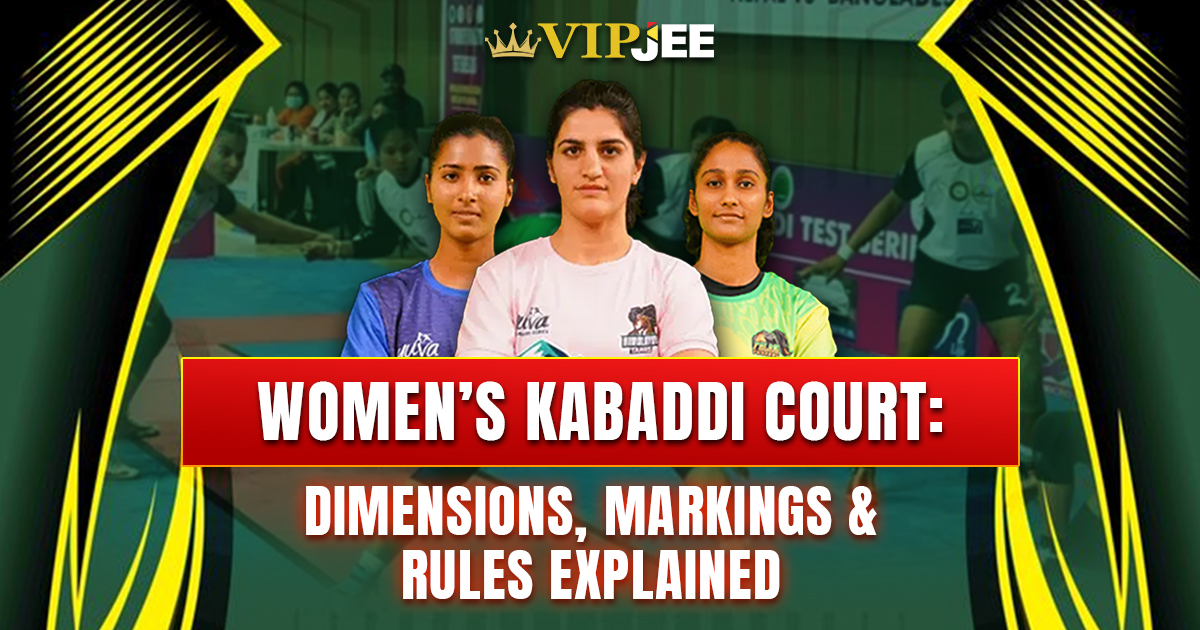Kabaddi, the homegrown sport of India, has transformed from rural roots to global recognition. With the launch of major tournaments like the Pro Kabaddi League, Asian Games, and Khelo India Youth Games, kabaddi has become one of the fastest-growing sports in South Asia. Within this movement, women’s kabaddi has carved out a niche of its own.
With more women participating at grassroots, collegiate, and national levels, the need for standardized courts and structured rules has never been more important. The women’s kabaddi court is specifically designed to accommodate differences in gameplay style, ensuring competitive integrity and safety.
In this in-depth article, we explore everything you need to know about the kabaddi court for women, from official measurements and court markings to surface types, gameplay rules, and how to set up a kabaddi court. Whether you’re organizing a school tournament, training athletes for state championships, or simply a kabaddi fan, this guide is tailored to inform, educate, and empower.
How Many Players Are There in Kabaddi? Team Size Explained
What Is Sport Kabaddi? A Beginner’s Guide to Rules & Terms
Why Understanding the Women’s Kabaddi Court Is a Game Changer
In a country where sports have long been male-dominated, kabaddi has emerged as a powerful platform for Indian women to showcase strength, agility, and strategy. The rise of events like the Pro Kabaddi Women’s League, Khelo India, and Senior National Championships has made it critical for players, coaches, and fans to understand the unique dynamics of the women’s kabaddi court.
From village grounds to international mats, the layout and structure of the kabaddi court define how the game is played. The official kabaddi court for women is tailored not only for fair competition but also for injury prevention and gameplay optimization. This guide will walk you through every inch of the court, the logic behind its measurements, and how it shapes modern-day women’s kabaddi in India and South Asia.
Whether you’re building a new court, organizing a school tournament, or simply following your favorite female kabaddi team, this article is your comprehensive reference.
Standard Women’s Kabaddi Court Measurement: Official Dimensions
Accurate court dimensions are fundamental to the quality and fairness of the game. The kabaddi women court measurement follows standards set by the Amateur Kabaddi Federation of India (AKFI) and the International Kabaddi Federation (IKF).
Official Dimensions for Women’s Kabaddi Court
- Length: 11 meters
- Width: 8 meters
This rectangular court is divided by a midline and features critical markings like the baulk line and bonus line. Compared to the men’s kabaddi court (13m x 10m), the women’s court is slightly smaller, allowing for faster gameplay and better adaptation to players’ agility.
Free Zone Requirements
Beyond the court lines, a free zone or buffer of at least 1 meter is mandatory on all sides. This space acts as a safety cushion, especially when players make diving tackles or aggressive escapes.
Significance of Standardization
- Fair Play: Ensures consistency in tournaments across India
- Talent Transition: Helps players adapt to national and international platforms
- Infrastructure Planning: Assists sports authorities in constructing compliant courts
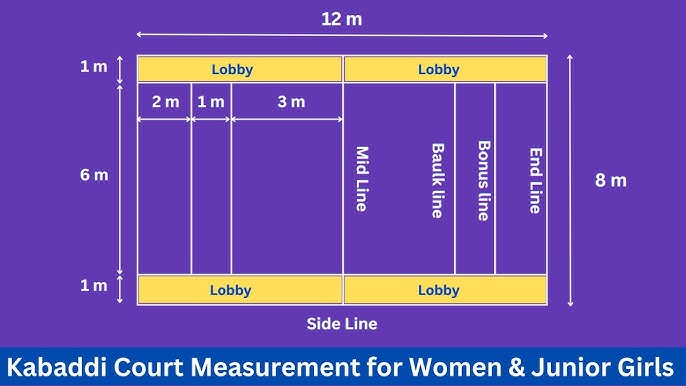
Read More: Top Indian Kabaddi Players: Famous Names You Should Know
Detailed Court Line Markings in Women’s Kabaddi
A kabaddi court is not just a rectangle; it’s a tactical battlefield marked by lines that define strategy, legality, and points.
1. Midline
- Central line dividing the court into two equal halves
- Teams take positions on either side
- Raiders start their move from behind this line
2. Baulk Line
- Drawn 3 meters from the midline on each side
- A raider must cross the baulk line with at least one foot to attempt a legal raid
- Failure to cross results in a self-out
3. Bonus Line
- Positioned 1 meter beyond the baulk line
- Becomes active only when six or more defenders are on the court
- Crossing this line while maintaining body balance earns the raider a bonus point
4. End Line
- Marks the rear boundary of the court
- If a raider crosses it without scoring, they are declared out
5. Lobbies
- Rectangular lanes running parallel to the sidelines
- Activated only when a defender is touched
- Smart use of the lobby can make or break a raid

Women’s Kabaddi Rules and Gameplay
While the essence of kabaddi remains the same across genders, women’s kabaddi has certain structural and stylistic variations that reflect in match duration, scoring tendencies, and tactical setups.
Match Format
- Two halves of 20 minutes each
- 5-minute halftime break
- Teams can make up to five substitutions during the match
Team Composition
- 7 players on court per team
- Up to 5 substitute players in reserve
- Minimum 5 players needed to continue a match
Scoring System
- Touch Points: Touching a defender and returning safely
- Bonus Points: Crossing the bonus line with one leg inside the court
- All-Out Points: When all opponents are declared out, 2 bonus points awarded
- Technical Points: Penalizing rule violations
Gameplay Traits in Women’s Matches
- Focus on agility, tactical positioning, and quick escapes
- Usage of chain tackles and corner holds common in defense
- Shorter raids but more calculated risks, especially in elite tournaments
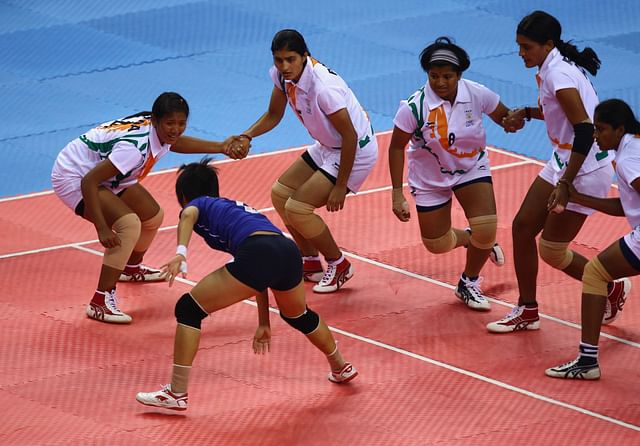
Read More: Kabaddi Winners List: Complete World Cup Champions Overview
Why the Women’s Kabaddi Court Size and Layout Are Important
Enhances Player Safety
- Smaller court size reduces physical overexertion
- Minimized risk of collision or injuries
Supports Strategic Gameplay
- Shorter distances favor agile raiders
- Encourages smart defending and fast recovery
Ensures Regulatory Compliance
- Most tournaments in India and South Asia follow AKFI or IKF guidelines
- Proper layout essential for eligibility in:
- Pro Kabaddi Women’s League
- Senior Nationals
- University and Inter-School Competitions
Community and Grassroots Impact
- Helps schools, colleges, and training academies build proper facilities
- Contributes to growth of female participation in sports across India
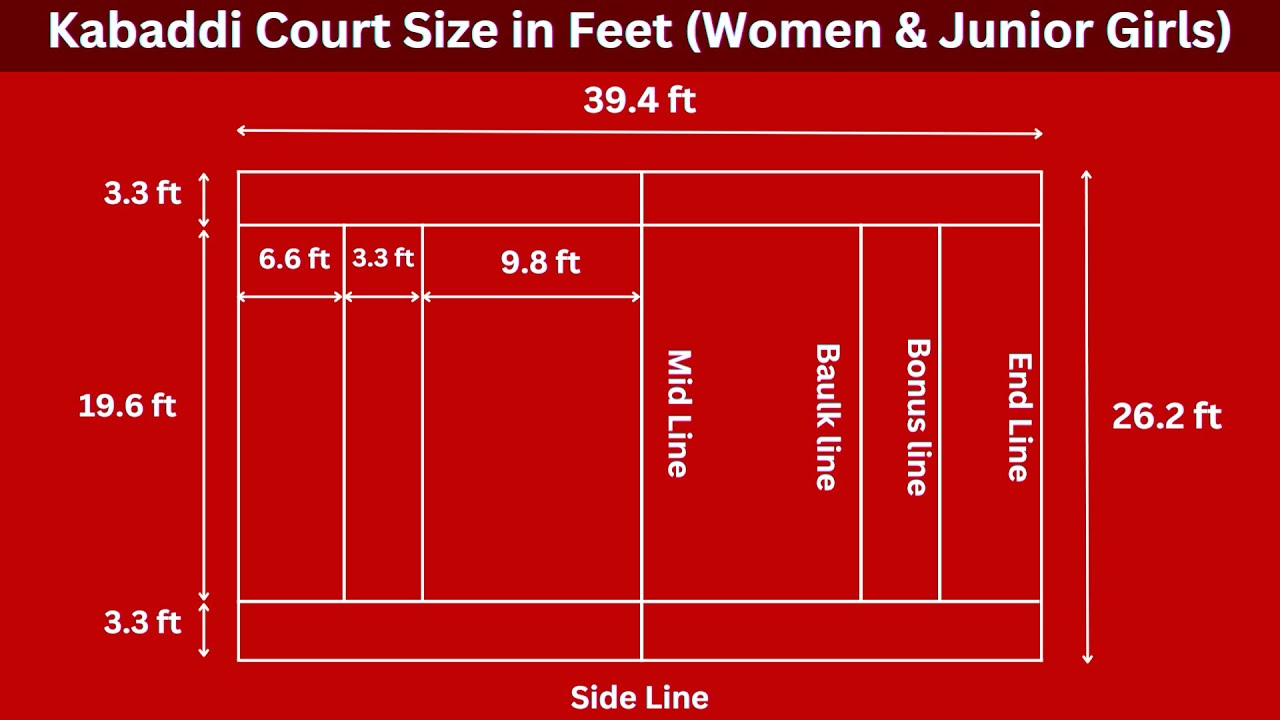
Court Surface Types for Women’s Kabaddi in India
Kabaddi’s appeal across urban and rural India has resulted in a wide variety of playing surfaces, each offering unique gameplay dynamics.
1. Mud/Clay Surface
- Common in rural India
- Soft and safe for beginners
- Requires regular maintenance
2. Synthetic Mats
- Standard in professional settings
- Reduces impact injuries
- Promotes faster movement
3. Grass/Turf Fields
- Occasionally used in schools
- Hybrid between mud and synthetic
- Not recommended for competitive tournaments
Impact on Performance
- Mud slows down the game; favors defenders
- Synthetic allows faster raids and smoother tackles
- Mats preferred for national-level women’s kabaddi
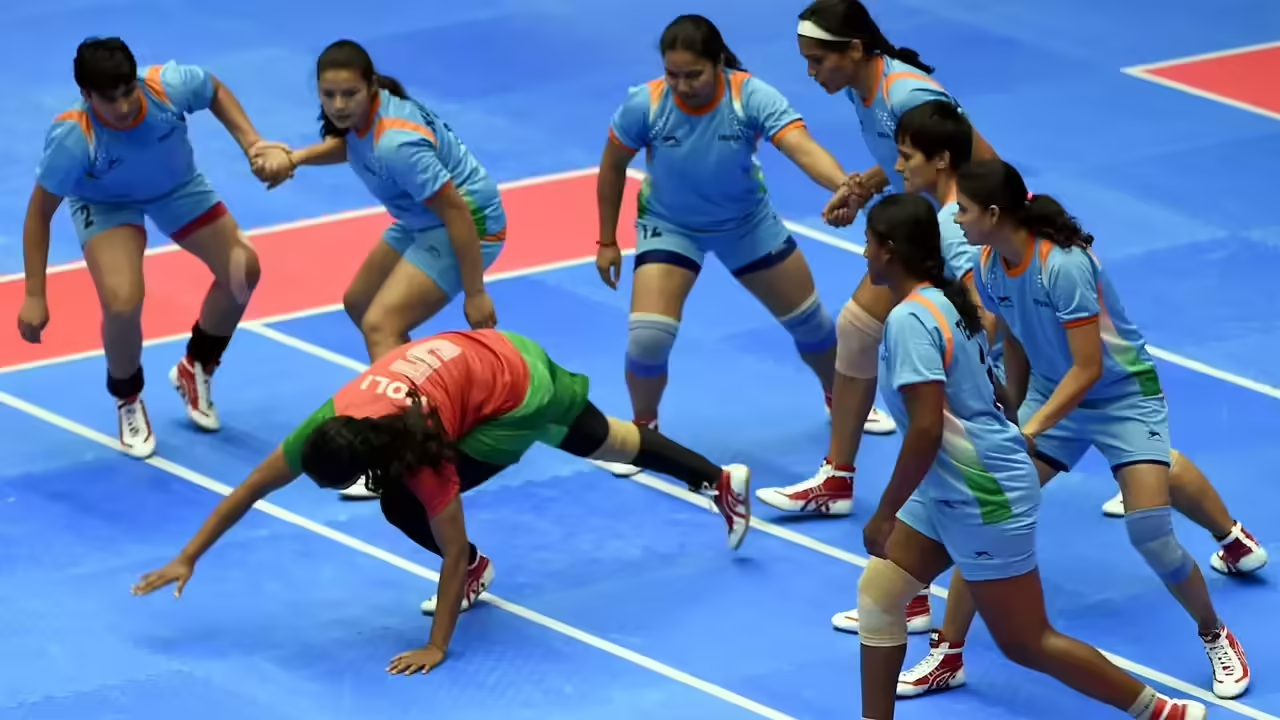
Setting Up a Women’s Kabaddi Court: Step-by-Step Guide
Organizing a women’s kabaddi match? Here’s how you can set up a compliant and effective kabaddi court.
1. Select the Location
- Prefer flat, open space
- For synthetic courts, ensure proper flooring
2. Mark the Boundaries
- Use chalk, paint, or lime powder
- Measure 11m x 8m for main court
- Add 1m buffer on all sides
3. Add Line Markings
- Midline
- Baulk lines (3m from midline)
- Bonus lines (1m beyond baulk)
- End lines
- Lobbies (1m wide on each side)
4. Gather Equipment
- Measuring tape
- Cones/flags
- Scoreboard
- Whistles and stopwatch
- Mats (optional but recommended)

The Rise of Women’s Kabaddi in India
From Grassroots to Global Platforms
Over the past decade, India has seen a dramatic surge in women’s participation in kabaddi. What was once a village sport played barefoot on dusty fields has now taken center stage in national sports discussions. Women’s kabaddi teams are now featured in government sports initiatives, and players are being scouted from schools, colleges, and rural training centers.
Key Milestones in Indian Women’s Kabaddi
- 2010: India’s women’s kabaddi team wins gold at the Asian Games
- 2016: Introduction of women’s matches in Pro Kabaddi exhibitions
- 2022: Khelo India adds dedicated women’s kabaddi division
- 2024: Inaugural Pro Kabaddi Women’s League announced
Government and NGO Support
Government bodies and NGOs are actively promoting kabaddi through sports development programs, scholarships, and tournaments tailored for women. This institutional support has led to better infrastructure, including dedicated courts, coaching staff, and athlete development programs.
Popular Tournaments Featuring the Women’s Kabaddi Court
Khelo India Youth Games
A flagship sports initiative in India, Khelo India features state-level kabaddi tournaments that follow official women’s kabaddi court measurements. Young female athletes from schools and rural academies participate and get scouted for higher-level competitions.
Senior National Kabaddi Championships
Held annually under the guidance of the Amateur Kabaddi Federation of India, this event is crucial for professional recognition. The court specifications, gameplay rules, and refereeing are aligned with international standards.
Pro Kabaddi Women’s League (PKWL)
Set to revolutionize women’s kabaddi in India, the upcoming Pro Kabaddi Women’s League will use advanced mat courts, high-definition broadcast, and strict adherence to international rules and court standards. This league is expected to inspire the next generation of kabaddi stars.
Read More: Captain of India Kabaddi Team: Current Leader & Full Captain List
Women’s Kabaddi Court vs Men’s Court: A Comparison
Key Dimension Differences
| Feature | Women’s Kabaddi Court | Men’s Kabaddi Court |
| Length | 11 meters | 13 meters |
| Width | 8 meters | 10 meters |
| Bonus Line Distance | 1 meter from baulk line | 1 meter from baulk line |
| Baulk Line Distance | 3 meters from midline | 3.75 meters from midline |
Gameplay Dynamics
- Women’s matches typically involve faster, more tactical raids.
- Men’s games often emphasize power and strength.
- Women’s teams may rely more on coordinated defense than solo tackles.
Read More: Kabaddi Live Score Points Table: Today’s Match & Results Update
How to Build a Women’s Kabaddi Court: Tools, Cost & Materials
Step-by-Step Construction Plan
1. Select a flat open area with drainage and proper fencing.
2. Measure and mark the court (11m x 8m) using lime or paint.
3. Prepare the surface (mud or synthetic mat as needed).
4. Draw key lines: midline, baulk line, bonus line, end line.
5. Install scoreboards, seating, and lighting if necessary.
Estimated Costs (India-based)
| Item | Mud Surface Cost | Mat Surface Cost |
| Ground Preparation | ₹8,000 | ₹15,000 |
| Marking & Line Materials | ₹2,000 | ₹2,000 |
| Synthetic Mat Installation | — | ₹60,000+ |
| Equipment (whistle, scoreboard) | ₹3,000 | ₹3,000 |
| Total Estimate | ₹13,000 | ₹80,000+ |
Training & Fitness Tips for Female Kabaddi Players
Conditioning Exercises
- Sprinting and shuttle runs to boost raid and retreat speed
- Agility ladder drills for fast footwork
- Bodyweight squats and lunges for leg strength
Skill-Specific Drills
- Solo raids with cones to simulate defender zones
- Two-on-one defense tackles
- Bonus line reach practice with balance focus
Common Injuries and Safety Tips in Women’s Kabaddi
Frequent Injuries
- Ankle sprains due to sudden direction changes
- Knee ligament strain from lunges or tackles
- Shoulder bruises during defense holds
Preventive Measures
- Always warm up and stretch before matches
- Use ankle braces for added support
- Ensure proper hydration and rest between games

The Role of Kabaddi in Women’s Empowerment
Breaking Gender Stereotypes
Kabaddi has offered a powerful platform for challenging traditional gender roles, particularly in rural parts of India. Female kabaddi players often become local icons, representing courage and independence.
Socio-Economic Opportunities
Participation in kabaddi provides women with access to scholarships, government sports quotas, and career options in coaching and physical education. Tournaments also offer cash prizes and endorsements, especially as media attention grows.
Community and Cultural Impact
Women participating in kabaddi often drive positive change within their communities, encouraging more families to invest in girls’ education, fitness, and public engagement.
Nutrition and Recovery for Women Kabaddi Players
Key Nutritional Needs
- Balanced intake of proteins, carbohydrates, and healthy fats
- Iron-rich foods to counter fatigue and anemia
- Hydration through water, coconut water, and electrolyte drinks
Recovery Techniques
- Cool-down stretches and foam rolling
- Ice baths or compression therapy after intense matches
- Adequate sleep and rest cycles

How Schools and Academies Can Promote Women’s Kabaddi
Infrastructure & Accessibility
- Allocate budget for dedicated women’s kabaddi courts
- Offer flexible scheduling for female athletes
- Provide uniforms, gear, and nutrition support
Talent Identification & Coaching
- Organize inter-school kabaddi tournaments
- Partner with local federations for training workshops
- Recognize outstanding performers with awards and certificates

Recommended Guides to Learn More About Women Kabaddi
🔗 India Women Kabaddi Team: Players, Matches & Pro League Info
🔗 Women Kabaddi World Cup: 2025 Final, Winners & Asian Games
Conclusion
The women’s kabaddi court is more than just a designated area for play, it’s a symbol of rising opportunities, structured competition, and grassroots empowerment. With its carefully calculated dimensions, clearly defined markings, and game-specific layout, the court embodies the evolution of women’s sports in India.
By standardizing the women’s kabaddi court measurement, national and local governing bodies ensure that every player, from the schoolgirl in a small town to the professional athlete representing India, competes on a level playing field. The growth of women’s kabaddi reflects broader changes in society, more inclusivity, greater representation, and a celebration of athletic excellence regardless of gender.
Kabaddi is no longer confined to the dusty grounds of villages. Today, it thrives in arenas, broadcasts, and classrooms. And at the heart of this transformation is the court, a structured, standardized, and sacred space where women prove time and again that they are just as fast, fierce, and fearless.
FAQs About Women’s Kabaddi Court
Q: 1. What are the official kabaddi court dimensions for women?
A: 11 meters long and 8 meters wide, as per AKFI regulations.
Q: 2. How many players are allowed in a women’s kabaddi team?
A: Each team has 7 on-court players and 5 substitutes.
Q: 3. Is the bonus line active at all times?
A: No. It is only active when 6 or more defenders are on the mat.
Q: 4. Can mud courts be used for official women’s matches?
A: Yes, but synthetic mats are preferred for higher-level events.
Q: 5. Are women’s kabaddi rules different from men’s?
A: The basic rules are the same, but gameplay style and strategies may differ.
So, are you excited to watch women kabaddi? In every meter of the women’s kabaddi court lies the spirit of resilience, the thrill of strategy, and the rise of a new generation of champions.
🎯Read more if you want to see more articles about betting: https://vipjee.com/

Kabir’s Winning Compass?
🎰 Trusted casino reviews
🏏 smart sports betting tips & 🃏 Real gambling game strategies
🧭 Follow Kabir’s Winning Compass — where smart players win more.

